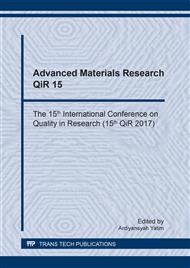[1]
S. H. Lee and S. Wang, Biodegradable polymers/bamboo fiber biocomposite with bio-based coupling agent, Compos. Part A. Appl. Sci. Manuf., vol. 37, no. 1, (2006) 80–91.
DOI: 10.1016/j.compositesa.2005.04.015
Google Scholar
[2]
L. Yu, K. Dean, and L. Li, Polymer blends and composites from renewable resources, Prog. Polym. Sci. 31 (2006) 576–602.
DOI: 10.1016/j.progpolymsci.2006.03.002
Google Scholar
[3]
D. Bachtiar, S. M. Sapuan, and M. M. Hamdan, Materials & Design The effect of alkaline treatment on tensile properties of sugar palm fibre reinforced epoxy composites, Materials and Design 29 (2008) 1285–1290.
DOI: 10.1016/j.matdes.2007.09.006
Google Scholar
[4]
M. Chalid and I. Prabowo, The Effects of Alkalization to the Mechanical Properties of the Ijuk Fiber Reinforced PLA Biocomposites, International Journal of Chemical, Molecular, Nuclear, Materials and Metallurgical Engineering Vol:9, No:2, (2015).
Google Scholar
[5]
S. Moritomi, T. Watanabe, and S. Kanzaki, Polypropylene Compounds for Automotive Applications, SUMITOMO KAGAKU,, vol. I (2010).
Google Scholar
[6]
E. Yuanita, J. N. Pratama, J. H. Mustafa, and M. Chalid, Multistages Preparation for Microfibrillated Celluloses Based on Arenga Pinnata ijuk' fiber,,Procedia Chem., vol. 16, (2015) 608–615.
DOI: 10.1016/j.proche.2015.12.099
Google Scholar
[7]
B. Irawan and N. Sutrisna, Prospek pengembangan sorgum di Jawa Barat mendukung diversifikasi pangan, Forum Agro Ekon., vol. 7, no. 2, (2011) 87–105.
DOI: 10.21082/fae.v29n2.2011.99-113
Google Scholar
[8]
J. Dahlberg, J. Berenji, V. Sikora, and D. Latković, Assessing sorghum [Sorghum bicolor (L) Moench] germplasm for new traits: Food, fuels & unique uses, Maydica, vol. 56, no. 2, (2011) 85–92.
Google Scholar
[9]
A. Almodares and M. R. Hadi, Production of bioethanol from sweet sorghum : A review,"vol. 4, no. 9, (2009) 772–780.
Google Scholar
[10]
A. Almodares, M. Jafarinia, and M. R. Hadi, The Effects of Nitrogen Fertilizer on Chemical Compositions in Corn and Sweet Sorghum, vol. 6, no. 4, (2009) 441–446, (2009).
Google Scholar
[11]
L. Laopaiboon, S. Nuanpeng, P. Srinophakun, P. Klanrit, and P. Laopaiboon, Ethanol production from sweet sorghum juice using very high gravity technology: Effects of carbon and nitrogen supplementations, Bioresour. Technol., vol. 100, no. 18, (2009).
DOI: 10.1016/j.biortech.2009.03.046
Google Scholar
[12]
M. M. Kabir, H. Wang, K. T. Lau, and F. Cardona, Chemical treatments on plant-based natural fibre reinforced polymer composites: An overview, Compos. Part B Eng., vol. 43, no. 7, (2012) 2883–2892.
DOI: 10.1016/j.compositesb.2012.04.053
Google Scholar
[13]
M. Chalid, A. Rahman, R. Ferdian, Nofrijon, B. Priyono, On the tensile properties of polylactide (PLA)/Arenga pinnata ijuk, fibre composite, Macrolecular Symposia, Vol 353 (2015) pp.108-114, ISSN: 1521-3900.
DOI: 10.1002/masy.201550314
Google Scholar
[14]
Mochamad Chalid and Imam Prabowo, The Effects of Alkalization to the Mechanical Properties of Biocomposite PLA Reinforced the Ijuk Fibers, International Journal of Chemical, Nuclear, Materials and Metallurgical Engineering (9) 2, (2015).
Google Scholar
[15]
Mochamad Chalid, Evana Yuanita and Juniko Pratama, Study of Alkalization to the Crystallinity and the Thermal Behavior of Arenga Pinnata Ijuk, Fibers-based Poly(lactic acid) (PLA) Biocomposite, Materials Science Forum Vol 827 (2015).
DOI: 10.4028/www.scientific.net/msf.827.326
Google Scholar
[16]
Evana yuanita, Preparation of Micro Fibrillated Cellulose Based on Arenga Pinnata Ijuk, Fibre for Nucleating Agent of Polypropylene- Characterization, Macromol. symp., (2017) 61–68.
DOI: 10.1002/masy.201600039
Google Scholar
[17]
I Prabowo, J Nur Pratama, M Chalid, The effect of modified ijuk fibers to crystallinity of polypropylene composite, IOP Conf. Series: Materials Science and Engineering 223 (2017) 012020.
DOI: 10.1088/1757-899x/223/1/012020
Google Scholar
[18]
A Saputro, I Verawati, G Ramahdita, M Chalid, Preparation of micro-fibrillated cellulose based on sugar palm ijuk (Arenga pinnata) fibres through partial acid hydrolysis, IOP Conf. Series: Materials Science and Engineering 223 (2017) 012042.
DOI: 10.1088/1757-899x/223/1/012042
Google Scholar
[19]
M. K. Yakubu, M. S. Gumel, A. Umar, and R. Metelerkamp, Physico-mechanical Effects of Surface-modified Sorgum Stalk Powder on Reinforced Rubber, J. Reinf. Plast. Compos., vol. 29, no. 18, (2010) 2855–2868.
DOI: 10.1177/0731684409358470
Google Scholar
[20]
J. Zhong, H. Li, J. Yu, and T. Tan, Effects of Natural Fiber Surface Modification on Mechanical Properties of Poly(lactic acid) (PLA)/Sweet Sorghum Fiber Composites, Polym. Plast. Technol. Eng., vol. 50, no. 15, (2011) 1583–1589.
DOI: 10.1080/03602559.2011.557817
Google Scholar
[21]
C. Qi, V. Yadama, K. Guo, and M. P. Wolcott, Thermal conductivity of sorghum and sorghum-thermoplastic composite panels, Ind. Crops Prod., vol. 45, (2013) 455–460.
DOI: 10.1016/j.indcrop.2013.01.011
Google Scholar
[22]
C. Qi, V. Yadama, K. Guo, and M. P. Wolcott, Thermal stability evaluation of sweet sorghum fiber and degradation simulation during hot pressing of sweet sorghum-thermoplastic composite panels, Ind. Crops Prod., vol. 69, (2015) 335–343.
DOI: 10.1016/j.indcrop.2015.02.050
Google Scholar
[23]
G. Ramahdita, S. Ilmiati, L. Suryanegara, and A. Khalid, Preparation and Characterization for Sorgum-Based, Macromol. symp., (2017) 69–74.
DOI: 10.1002/masy.201600040
Google Scholar
[24]
Ismojo, P H Simanulang, A Zulfia, M Chalid, Preparation of micro-fibrillated cellulose from sorghum fibre through alkalization and acetylation treatments, IOP Conf. Series: Materials Science and Engineering 223 (2017) 012057.
DOI: 10.1088/1757-899x/223/1/012057
Google Scholar
[25]
M. J. M. Ridzuan, M. S. A. Majid, M. Afendi, S. N. A. Kana, J. M. Zahri, and A. G. Gibson, Characterisation of natural cellulosic fi bre from Pennisetum purpureum stem as potential reinforcement of polymer composites, vol. 89, (2016) 839–847.
DOI: 10.1016/j.matdes.2015.10.052
Google Scholar
[26]
H. P. S. A. Khalil, H. Ismail, H. D. Rozman, and M. N. Ahmad, The effect of acetylation on interfacial shear strength between plant, Eurpoean Polymer Journal 37, (2001) 1037–1045.
DOI: 10.1016/s0014-3057(00)00199-3
Google Scholar
[27]
A. Elamri, K. Abid, O. Harzallah, and A. Lallam, Characterization of Recycled / Virgin PET Polymers and their Composites, American Journal of Nano Research and Application vol. 3, no. 11, (2015) 11–16.
Google Scholar


